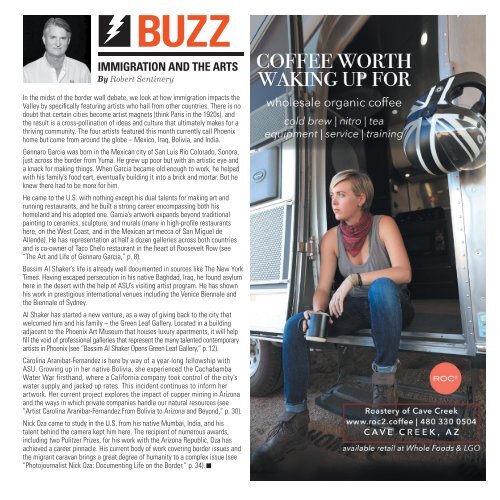JAVA Mar-2019
You also want an ePaper? Increase the reach of your titles
YUMPU automatically turns print PDFs into web optimized ePapers that Google loves.
IMMIGRATION AND THE ARTS<br />
By Robert Sentinery<br />
BUZZ<br />
In the midst of the border wall debate, we look at how immigration impacts the<br />
Valley by specifically featuring artists who hail from other countries. There is no<br />
doubt that certain cities become artist magnets (think Paris in the 1920s), and<br />
the result is a cross-pollination of ideas and culture that ultimately makes for a<br />
thriving community. The four artists featured this month currently call Phoenix<br />
home but come from around the globe – Mexico, Iraq, Bolivia, and India.<br />
Gennaro Garcia was born in the Mexican city of San Luis Rio Colorado, Sonora,<br />
just across the border from Yuma. He grew up poor but with an artistic eye and<br />
a knack for making things. When Garcia became old enough to work, he helped<br />
with his family’s food cart, eventually building it into a brick and mortar. But he<br />
knew there had to be more for him.<br />
He came to the U.S. with nothing except his dual talents for making art and<br />
running restaurants, and he built a strong career encompassing both his<br />
homeland and his adopted one. Garcia’s artwork expands beyond traditional<br />
painting to ceramics, sculpture, and murals (many in high-profile restaurants<br />
here, on the West Coast, and in the Mexican art mecca of San Miguel de<br />
Allende). He has representation at half a dozen galleries across both countries<br />
and is co-owner of Taco Chelo restaurant in the heart of Roosevelt Row (see<br />
“The Art and Life of Gennaro Garcia,” p. 8).<br />
Bassim Al Shaker’s life is already well documented in sources like The New York<br />
Times. Having escaped persecution in his native Baghdad, Iraq, he found asylum<br />
here in the desert with the help of ASU’s visiting artist program. He has shown<br />
his work in prestigious international venues including the Venice Biennale and<br />
the Biennale of Sydney.<br />
Al Shaker has started a new venture, as a way of giving back to the city that<br />
welcomed him and his family – the Green Leaf Gallery. Located in a building<br />
adjacent to the Phoenix Art Museum that houses luxury apartments, it will help<br />
fill the void of professional galleries that represent the many talented contemporary<br />
artists in Phoenix (see “Bassim Al Shaker Opens Green Leaf Gallery,” p. 12).<br />
Carolina Aranibar-Fernandez is here by way of a year-long fellowship with<br />
ASU. Growing up in her native Bolivia, she experienced the Cochabamba<br />
Water War firsthand, where a California company took control of the city’s<br />
water supply and jacked up rates. This incident continues to inform her<br />
artwork. Her current project explores the impact of copper mining in Arizona<br />
and the ways in which private companies handle our natural resources (see<br />
“Artist Carolina Aranibar-Fernandez:From Bolivia to Arizona and Beyond,” p. 30).<br />
Nick Oza came to study in the U.S. from his native Mumbai, India, and his<br />
talent behind the camera kept him here. The recipient of numerous awards,<br />
including two Pulitzer Prizes, for his work with the Arizona Republic, Oza has<br />
achieved a career pinnacle. His current body of work covering border issues and<br />
the migrant caravan brings a great degree of humanity to a complex issue (see<br />
“Photojournalist Nick Oza: Documenting Life on the Border,” p. 34).

















